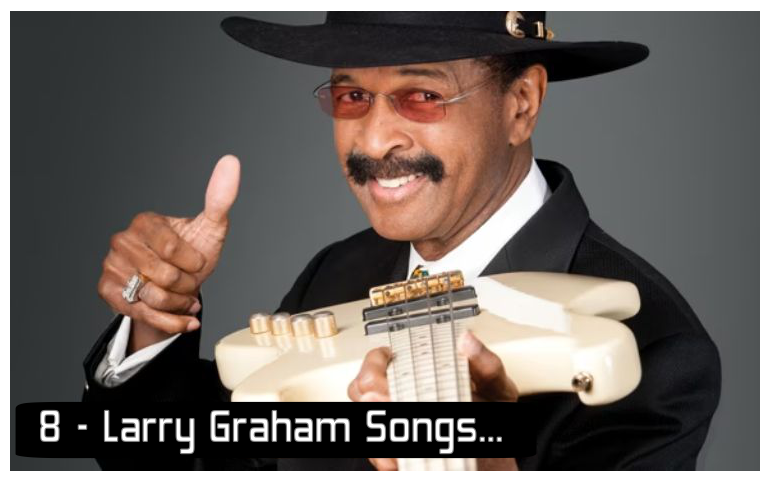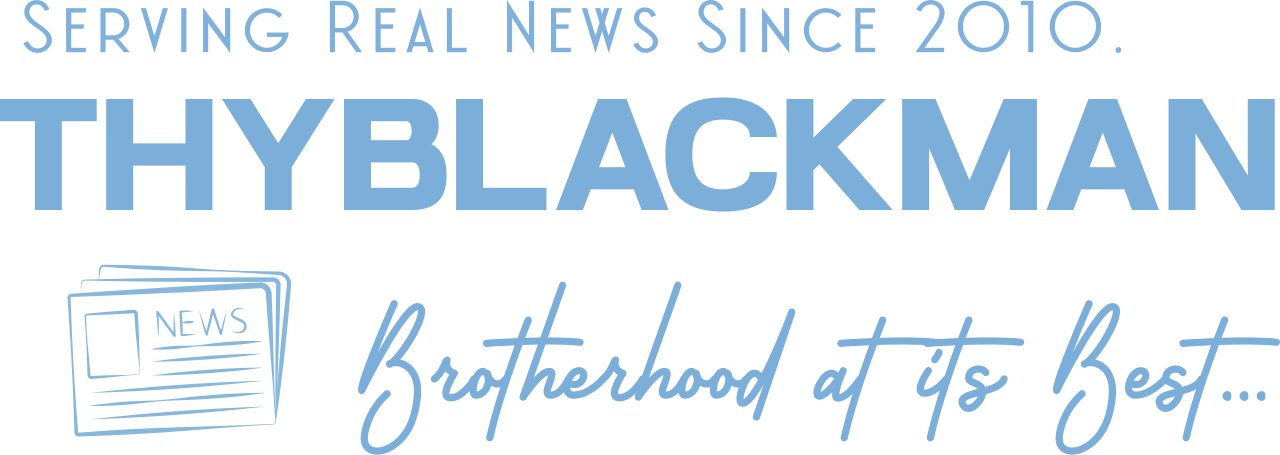(ThyBlackMan.com) Few artists have had a more significant influence on both funk and soul music than Larry Graham. As the pioneering bassist of Sly and the Family Stone and the dynamic frontman of Graham Central Station, Graham didn’t just play music—he redefined how the bass guitar could drive a song. Often credited with inventing the “slap bass” technique, his innovations laid the foundation for generations of funk, R&B, and even hip-hop musicians to follow.
But Graham’s artistry goes far beyond his technical contributions. His music is rich with emotion, groove, and spirituality. Whether delivering high-energy funk anthems or heartfelt soul ballads, Graham’s catalog remains timeless and deeply resonant. For longtime fans and new listeners alike, these eight songs highlight the depth of his work—songs that continue to inspire, uplift, and groove listeners across generations.

1. One in a Million You
This soulful ballad might be Larry Graham’s most recognizable solo hit, and for good reason. Released in 1980, “One in a Million You” took a dramatic departure from his funk roots and introduced the world to his velvety tenor voice. It’s a love song so sincere and polished, it continues to soundtrack weddings, anniversaries, and romantic moments decades later.
What makes this song resonate so deeply is its simplicity and heartfelt delivery. The orchestration is lush yet reserved, allowing Graham’s vocals to sit front and center. His phrasing—gentle, clear, and emotive—delivers each lyric with conviction, making listeners believe every word. There’s no over-singing or unnecessary flair, just raw emotion. The background instrumentation, including the soft piano and string arrangements, creates a soothing bed for Graham’s voice to float above.
There’s something undeniably timeless about the melody and message. “You’re one in a million” isn’t just a compliment—it’s a statement of deep admiration and reverence. In an era where relationships often feel transactional or performative in music, Graham’s sincerity is a breath of fresh air. This track isn’t about fleeting attraction; it’s about a once-in-a-lifetime connection.
Graham proved with this one song that he wasn’t just a funk pioneer—he was a masterful vocalist and storyteller. It continues to remind us that love songs never go out of style when they’re sung from the heart. In playlists today, it still sits comfortably beside Luther Vandross, Peabo Bryson, and Teddy Pendergrass—reminding younger generations that real love deserves a real soundtrack.
2. Hair
“Hair” might sound like a whimsical title, but it’s one of the most energetic and funky tracks in Larry Graham’s arsenal. Performed with Graham Central Station, the song is an unapologetic celebration of self-expression and Black identity—especially important during the cultural shifts of the 1970s.
Musically, “Hair” is a slap-bass clinic. From the opening seconds, Graham delivers punchy, syncopated grooves that serve as both melody and rhythm. The wah-wah guitars, tight horn sections, and gospel-influenced background vocals elevate the track into a full-blown funk revival. It’s impossible not to move your body when this song comes on. It has the rhythmic complexity of James Brown, but with the gospel soul of church revival energy.
Lyrically, it’s fun and liberating. “They say your hair is your glory” becomes a mantra for individuality. In a world still grappling with Eurocentric beauty standards, Graham turned the spotlight back toward pride in natural Black hair and the unique beauty of funk culture. He wasn’t just singing about hair—he was uplifting a generation that had been taught to hide or change theirs.
What’s truly special is how “Hair” balances message and movement. It’s deep but danceable, political yet playful. In today’s era of natural hair movements and cultural appreciation, “Hair” feels like a funky anthem that was ahead of its time. Listening to it now feels both nostalgic and fresh, and it’s a reminder that funk has always been a vehicle for empowerment—and joy.
3. The Jam
This track is pure, unfiltered funk. Clocking in at over eight minutes, “The Jam” is a celebration of improvisation and live energy. It’s the kind of song that puts musicianship on full display while never losing its sense of groove or purpose. This wasn’t just a song—it was a movement, a chance for the band to stretch, explore, and connect with the audience in real time.
Graham’s bass slapping in “The Jam” is nothing short of revolutionary. He turns his instrument into a lead voice, punching through the mix with percussive fury. The track also features extended solos, call-and-response vocals, and a dynamic structure that feels more like a live performance than a studio track. It’s alive—breathing and shifting in ways most recorded songs never dare to.
One of the song’s greatest achievements is how it fuses musical complexity with accessibility. Musicians marvel at the technicality, but even casual listeners get swept up in the infectious rhythm. It’s not showing off—it’s sharing. Graham invites you in, makes you part of the moment, and keeps you there with a beat that never lets up.
For modern listeners who love jam bands or extended house grooves, “The Jam” offers that same immersive experience with a funk twist. It’s music made for dance floors, park jams, and anyone who appreciates a tight band giving it their all. And like the best jams, it’s never about how long it lasts—it’s about how long it feels. With “The Jam,” every minute is electric.
4. Now Do-U-Wanta Dance
This track’s title is more than a question—it’s a challenge. Released during the disco-funk craze of the late ’70s, “Now Do-U-Wanta Dance” was Graham Central Station’s contribution to the dance floor revolution. And yes, it lives up to its name. It’s bold, brassy, and brimming with contagious energy from the first note.
Right from the start, the song hits with relentless energy. The drums are sharp, the bass is propulsive, and the keyboards weave a hypnotic rhythm that dares you to sit still. Graham’s voice floats over the top, almost teasing, as he demands a physical response. It’s funk designed for fun—nothing more, nothing less. But beneath the surface is a tightly arranged masterpiece that proves just how well Graham understood momentum and crowd psychology.
The brilliance here lies in its structure. Just when you think the beat can’t go any harder, Graham throws in breakdowns, key changes, and vocal chants that elevate the track. You can almost feel the crowd’s reaction built into the composition. He was clearly feeding off the energy of live shows and capturing it in the studio, creating a communal experience in every recording.
Even today, “Now Do-U-Wanta Dance” works in party playlists and retro DJ sets. It’s a prime example of how funk could be intelligent, precise, and wildly entertaining all at once. And beyond the groove, it reminds us that sometimes the best question isn’t “Do you hear it?”—it’s “Can you feel it?” This song makes sure the answer is always yes.
5. It’s Alright
By the time the early ‘80s rolled around, Larry Graham had transitioned into more adult-contemporary and smooth R&B territory, but “It’s Alright” proves he never lost that soulful touch. Released on the heels of “One in a Million You,” this track continues the romantic vibe with slightly more upbeat instrumentation. It’s not just a love song—it’s a sonic embrace meant to soothe anxieties and lift the spirit.
“It’s Alright” mixes a mid-tempo groove with Graham’s signature falsetto, layered gently over soft synth pads, understated rhythm guitar, and subtle drum patterns. The song strikes a comforting tone—offering reassurance in the face of uncertainty, whether it be in love or life. The chorus is catchy and uplifting, grounded in a gospel sensibility that reminds listeners that everything will work out in time.
Lyrically, Graham strikes a balance between vulnerability and optimism. He doesn’t gloss over life’s troubles; instead, he meets them head-on with grace and empathy. Lines like “Baby, don’t you worry, I’ll be here for you” aren’t just romantic clichés—they feel like promises whispered from someone who understands what it means to struggle and still hope. His delivery is honest, not flashy, with every note sounding lived-in and sincere.
There’s a warmth to the track that pairs perfectly with a relaxing evening or a long drive. It’s not about grand gestures—it’s about emotional presence. Like many of his ballads, “It’s Alright” provides a safe emotional space—a musical pep talk wrapped in smooth production. For today’s R&B lovers who appreciate artists like Kem, Anthony Hamilton, or Gregory Porter, this track feels like an overlooked gem from the blueprint era of soul ballads. It belongs in the canon of songs that heal rather than just entertain.
6. Release Yourself
Funk was always more than just music—it was about liberation. “Release Yourself” is one of Larry Graham’s most powerful tracks that speaks directly to that philosophy. It’s not just an invitation to dance—it’s a manifesto of spiritual, physical, and emotional freedom. From the moment it begins, it feels like Graham is urging you to unshackle yourself from whatever is weighing you down.
The song opens with a bold vocal declaration that immediately sets the tone: part preacher, part bandleader, part revolutionary. Graham isn’t just singing—he’s preaching. The funky groove kicks in with layered keyboards, syncopated percussion, and of course, that unmistakable slap bass that commands attention. It builds momentum with every measure, layering gospel-style backing vocals and call-and-response hooks that give it the feel of a Pentecostal revival filtered through a funk prism.
There’s a spiritual element here, and not just in the music. The lyrics encourage self-love, breaking free from inhibition, and embracing who you are. Graham challenges the listener to stop being bound by societal expectations or self-doubt. “Release yourself, let yourself be free,” isn’t just a catchy line—it’s therapy set to music.
“Release Yourself” remains relevant because the idea of personal liberation is timeless. Whether it’s dancing in your room to clear your mind or shaking off negativity from the day, this track provides the perfect soundtrack. It’s tailor-made for moments of emotional detox—be it a workout, a solo kitchen dance session, or a moment of self-empowerment. Few songs manage to inspire both physical movement and inner change. This one does.
7. Tell Me What It Is
“Tell Me What It Is” is funk storytelling at its finest. Built around a bluesy funk structure, the song delves into questions of love, trust, and confusion—classic soul themes, but with a modern (for the time) funk framework that keeps it danceable and real. While some tracks aim to escape heartache, this one sits with it, trying to make sense of the emotional haze.
Graham’s vocal approach here is slightly different—grittier and more conversational than on smoother cuts like “One in a Million You.” He’s not just singing; he’s talking to you, trying to get to the bottom of emotional turmoil. The lyrics feel like a real conversation between two people trying to understand one another in the middle of a romantic standoff. “You say one thing, but your eyes say another,” he pleads, perfectly capturing the dissonance many experience in love.
Instrumentally, the song grooves but doesn’t overpower. That’s a testament to Graham’s mastery of balance. The bass line walks a fine line between groove and gravity, while the electric keys fill the background with a smokey, late-night atmosphere. Background vocals elevate the drama without veering into melodrama, echoing his pleas in tight harmony that sounds like your friends trying to back you up in an argument.
Even today, “Tell Me What It Is” feels timely. It taps into the uncertainty and emotional confusion that so often accompanies love, especially in an age of mixed signals and unsent messages. It’s a funk song with emotional weight, perfect for when you want to dance and think. If Marvin Gaye had ever gone full funk, it might’ve sounded like this—personal, raw, and rhythmically irresistible.
8. Feel the Need
Rounding out the list is “Feel the Need,” a high-octane funk track that encapsulates everything that made Graham Central Station so unforgettable. Released in 1975, the song is a declaration of passion and urgency—with the band firing on all cylinders from start to finish. It’s a track that hits you in the chest with groove and doesn’t let go.
The groove is relentless. The bass snaps with pinpoint precision, the drums push forward with propulsive energy, and the keys swirl like a tornado of rhythm. Graham’s vocals sit right in the pocket, commanding and fiery. The refrain, “I feel the need,” becomes a call to action, repeated like a funk mantra that pulls you deeper into the track’s rhythm. It’s not just a desire—it’s a demand to move, to act, to feel.
There’s a wonderful layering of parts here. From gospel-style vocal chants to blazing horn stabs and instrumental breakdowns, the track builds to several mini climaxes. This dynamic structure gives it the feel of a journey rather than a static groove. Each section builds on the last, making the listener feel like they’re ascending a staircase of funk. Every instrument is doing something interesting—and yet, nothing sounds chaotic. It’s organized electricity.
“Feel the Need” is the kind of track that could still bring the house down at a funk festival today. It’s urgent, exciting, and proof that funk—when done right—is as visceral and soul-stirring as any genre out there. It invites you not just to listen, but to participate. And decades later, that need to connect through rhythm remains universal.
Larry Graham’s musical legacy is not only defined by his groundbreaking bass techniques but also by his ability to connect with audiences through rhythm, sincerity, and purpose. From iconic funk tracks that helped shape a genre to soul ballads that still stir emotion today, these eight selections capture the essence of his artistry.
For those exploring the roots of modern R&B, funk, and soul, Graham’s work remains essential listening. His songs are more than nostalgic moments—they are vibrant pieces of musical history that continue to sound fresh and relevant. Whether you’re discovering him for the first time or revisiting a legend, Larry Graham’s music is a masterclass in timeless sound.

















Leave a Reply